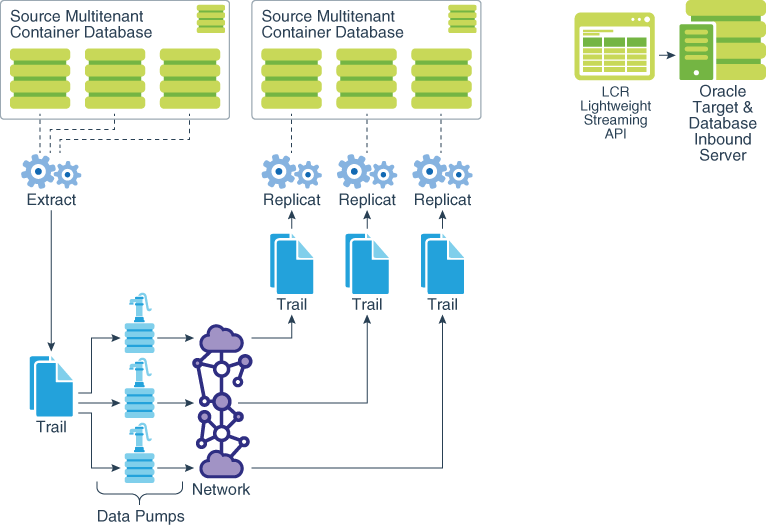5 Configuring Oracle GoldenGate in a Multitenant Container Database
Topics:
- Using Oracle GoldenGate with Pluggable Databases
In most ways, Oracle GoldenGate operates in a multitenant container database the same way that it operates in a regular Oracle Database. - Other Requirements for Multitenant Container Databases
This topic describes the special requirements that apply to replication to and from multitenant container databases.
5.1 Using Oracle GoldenGate with Pluggable Databases
In most ways, Oracle GoldenGate operates in a multitenant container database the same way that it operates in a regular Oracle Database.
Consider the following instructions as the foundation for following the actual configuration instructions in the following chapters:
Configuring Capture in Integrated Mode
Configuring Oracle GoldenGate Apply
Topics:
5.1.1 Capturing from Pluggable Databases
One Extract group can capture from multiple pluggable databases to a single trail. In the parameter file, source objects must be specified in TABLE and SEQUENCE statements with their fully qualified three-part names in the format of container.schema.object.
As an alternative to specifying three-part names, you can specify a default pluggable database with the SOURCECATALOG parameter, and then specify only the schema.object in subsequent TABLE or SEQUENCE parameters. You can use multiple instances of this configuration to handle multiple source pluggable databases. For example:
SOURCECATALOG pdb1 TABLE schema*.tab*; SEQUENCE schema*.seq*; SOURCECATALOG pdb2 TABLE schema*.tab*; SEQUENCE schema*.seq*;
Parent topic: Using Oracle GoldenGate with Pluggable Databases
5.1.2 Applying to Pluggable Databases
Replicat can only connect and apply to one pluggable database. To specify the correct one, use a SQL*Net connect string for the database user that you specify with the USERID or USERIDALIAS parameter. For example: GGADMIN@FINANCE. In the parameter file, specify only the schema.object in the TARGET portion of the MAP statements. In the MAP portion, identify source objects captured from more than one pluggable database with their three-part names or use the SOURCECATALOG parameter with two-part names. The following is an example of this configuration.
SOURCECATALOG pdb1 MAP schema*.tab*, TARGET *1.*; MAP schema*.seq*, TARGET *1.*; SOURCECATALOG pdb2 MAP schema*.tab*, TARGET *2.*; MAP schema*.seq*, TARGET *2.*;
The following is an example without the use of SOURCECATALOG to identify the source pluggable database. In this case, the source objects are specified with their three-part names.
MAP pdb1.schema*.tab*, TARGET *1.*; MAP pdb1.schema*.seq*, TARGET *1.*;
To configure replication from multiple source pluggable databases to multiple target pluggable databases, you can configure parallel Extract and Replicat streams, each handling data for one pluggable database. Alternatively, you can configure one Extract capturing from multiple source pluggable databases, which writes to one trail that is read by multiple Replicat groups, each applying to a different target pluggable database. Yet another alternative is to use one Extract writing to multiple trails, each trail read by a Replicat assigned to a specific target pluggable database :
Parent topic: Using Oracle GoldenGate with Pluggable Databases
5.1.3 Excluding Objects from the Configuration
To exclude pluggable databases, schemas, and objects from the configuration, you can use the CATALOGEXCLUDE, SCHEMAEXCLUDE, TABLEEXCLUDE, MAPEXCLUDE, and EXCLUDEWILDCARDOBJECTSONLY parameters. See Reference for Oracle GoldenGate for more information.
Parent topic: Using Oracle GoldenGate with Pluggable Databases
5.2 Other Requirements for Multitenant Container Databases
This topic describes the special requirements that apply to replication to and from multitenant container databases.
The requirements are:
-
The different pluggable databases in the multitenant container database can have different character sets. Oracle GoldenGate captures data from any multitenant database with different character sets into one trail file and replicates the data without corruption due to using different character sets.
-
Extract must operate in integrated capture mode. See Deciding Which Capture Method to Use for more information about Extract capture modes. Replicat can operate in any of its modes.
-
Extract must connect to the root container (
cdb$root) as a common user in order to interact with the logmining server. To specify the root container, use the appropriate SQL*Net connect string for the database user that you specify with theUSERIDorUSERIDALIASparameter. For example:C##GGADMIN@FINANCE. See Establishing Oracle GoldenGate Credentials for how to create a user for the Oracle GoldenGate processes and grant the correct privileges. -
To support source CDB 12.2, Extract must specify the trail format as release 12.3.
-
The
dbms_goldengate_auth.grant_admin_privilegepackage grants the appropriate privileges for capture and apply within a multitenant container database. This includes thecontainerparameter, which must be set toALL, as shown in the following example:dbms_goldengate_auth.grant_admin_privilege('C##GGADMIN',container=>'all')
